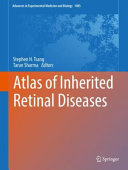Gaining insight on how to make a specific diagnosis

Leigh Spielberg
Published: Saturday, February 1, 2020
 Inherited retinal diseases (IRDs) are not a simple group to learn. It’s not that the pathology is inherently more difficult than any other. Instead, making a specific diagnosis can take so long that, as residents, by the time the diagnosis has been made for that one interesting case during your residency’s retina rotation, most residents have already moved on to a new rotation. This, along with the phenotypic heterogeneity make mastering this subfield of retinal disease especially challenging.
The “Atlas of Inherited Retinal Diseases” (Springer), edited by Stephen H. Tsang and Tarun Sharma might deliver some insight. It “provides a thorough overview of various inherited retinal dystrophies with emphasis on phenotype characteristics and how they relate to the most frequently encountered genes”.
This 260-page book is a true atlas and, as with other retina atlases, images are the primary focus. Particularly striking are the fundus autofluorescence images, which are crucial to diagnosis and follow-up. The clear depictions and analysis of the OCT images are also crucial, as this is the most commonly used retinal imaging modality and the most likely way that these retinal abnormalities will first be detected.
Comprised of eight sections, it opens with an overview of basic principles of the imaging modalities used to manage patients with IRDs. Sections 2, 3 and 4 categorises the diseases based on their inheritance pattern (X-linked, autosomal dominant and autosomal recessive, respectively), while section 5 is dedicated to those IRDs associated with systemic manifestations. Section 6 illustrates the genetic phakomatoses and section 7 describes IRDs with no known underlying genetic mutations. Section 8 offers a practical approach to IRDs for the clinician, the genetic testing and its interpretation.
This atlas is intended for ambitious residents, retina fellows and retina specialists who are tasked with managing patients with IRDs. PhD students and researchers will also benefit from this text, as they might otherwise rarely encounter the phenotypes of the genes they work on.
With its highly organised structure and clear overview of rarer retinal disease, it can also help the ready study for large examinations.
Inherited retinal diseases (IRDs) are not a simple group to learn. It’s not that the pathology is inherently more difficult than any other. Instead, making a specific diagnosis can take so long that, as residents, by the time the diagnosis has been made for that one interesting case during your residency’s retina rotation, most residents have already moved on to a new rotation. This, along with the phenotypic heterogeneity make mastering this subfield of retinal disease especially challenging.
The “Atlas of Inherited Retinal Diseases” (Springer), edited by Stephen H. Tsang and Tarun Sharma might deliver some insight. It “provides a thorough overview of various inherited retinal dystrophies with emphasis on phenotype characteristics and how they relate to the most frequently encountered genes”.
This 260-page book is a true atlas and, as with other retina atlases, images are the primary focus. Particularly striking are the fundus autofluorescence images, which are crucial to diagnosis and follow-up. The clear depictions and analysis of the OCT images are also crucial, as this is the most commonly used retinal imaging modality and the most likely way that these retinal abnormalities will first be detected.
Comprised of eight sections, it opens with an overview of basic principles of the imaging modalities used to manage patients with IRDs. Sections 2, 3 and 4 categorises the diseases based on their inheritance pattern (X-linked, autosomal dominant and autosomal recessive, respectively), while section 5 is dedicated to those IRDs associated with systemic manifestations. Section 6 illustrates the genetic phakomatoses and section 7 describes IRDs with no known underlying genetic mutations. Section 8 offers a practical approach to IRDs for the clinician, the genetic testing and its interpretation.
This atlas is intended for ambitious residents, retina fellows and retina specialists who are tasked with managing patients with IRDs. PhD students and researchers will also benefit from this text, as they might otherwise rarely encounter the phenotypes of the genes they work on.
With its highly organised structure and clear overview of rarer retinal disease, it can also help the ready study for large examinations.